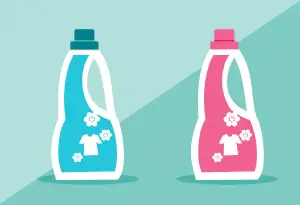Say Goodbye to Grease Stains: Effective Tips to Remove Grease Stains from Clothes at Home

- Pre-Treatment: Acting Fast to Prevent Set-In Stains
- Step 1: Absorb and Scrape Off Excess Grease
- Step 2: Apply Dish Soap or Liquid Laundry Detergent
- Step 3: Gently Rub and Rinse the Stained Area
- Step 4: Treat Stubborn Stains with Stain Remover or Vinegar
- Step 5: Launder as Usual, Checking for Residual Stains
- Additional Tips and Precautions for Different Fabrics
Grease stains on clothes can be a nightmare to deal with. Whether it's from cooking mishaps in the kitchen or accidental spills while enjoying a delicious meal, grease stains have a way of stubbornly clinging to our favorite garments. These unsightly marks not only ruin the appearance of our clothes but can also be quite challenging to remove. However, with the right techniques and a little bit of patience, you can say goodbye to grease stains and restore your clothes to their former glory. In this article, we will explore effective tips to remove grease stains from clothes at home, so you can enjoy spotless, grease-free garments once again.
Pre-Treatment: Acting Fast to Prevent Set-In Stains
When it comes to grease stains, time is of the essence. Acting quickly can prevent the grease from setting into the fabric and becoming a stubborn stain. As soon as you notice a grease stain on your clothes, take immediate action to pre-treat it.
Start by blotting the stained area with a clean cloth or paper towel to absorb any excess grease. Avoid rubbing as it may spread the stain further. Next, gently scrape off any solid residue using a spoon or dull knife.
Remember, do not use hot water on grease stains as it can cause the grease to set in. Instead, opt for cold water which helps prevent further penetration of the stain. By acting fast and following these pre-treatment steps, you increase your chances of successfully removing grease stains from your clothes.
Step 1: Absorb and Scrape Off Excess Grease
When dealing with a grease stain on your clothes, the first step is to act quickly and remove as much of the excess grease as possible. Start by using a clean cloth or paper towel to blot the stain gently. Avoid rubbing, as this can push the grease deeper into the fabric.
Next, grab a dull knife or spoon and carefully scrape off any solidified grease from the surface of the fabric. Be gentle to avoid damaging the fabric fibers.
By absorbing and scraping off excess grease, you're minimizing the risk of it spreading further and setting into the fabric. This initial step sets the foundation for effective stain removal methods to follow.
Step 2: Apply Dish Soap or Liquid Laundry Detergent
Once you have absorbed and scraped off the excess grease, it's time to tackle the stain head-on. Grab a small amount of dish soap or liquid laundry detergent and apply it directly to the stained area. Gently rub the soap into the fabric, making sure to cover the entire stain.
Both dish soap and liquid laundry detergent are effective at breaking down grease and oil stains. Their powerful cleaning agents work to lift the grease particles from the fabric fibers, making them easier to remove.
Allow the soap to sit on the stain for about 10-15 minutes. This will give it enough time to penetrate deep into the fabric and loosen up the grease. Remember not to let it dry on the garment as this can make the stain more difficult to remove.
After letting it sit, rinse the stained area with cold water. You can either hold it under a running tap or use a clean cloth soaked in cold water to gently blot away any soapy residue.
By applying dish soap or liquid laundry detergent, you are taking a crucial step towards eliminating those stubborn grease stains from your clothes.
Step 3: Gently Rub and Rinse the Stained Area
After applying the dish soap or liquid laundry detergent, it's time to gently rub the stained area. Use your fingers or a soft brush to work the soap into the fabric. Be careful not to scrub too vigorously, as this may damage delicate fabrics.
Once you have thoroughly rubbed the stain, rinse the area with cold water. Hot water can set grease stains, so it's important to use cold water for this step. Hold the fabric under running water or submerge it in a basin filled with cold water.
Continue rinsing until you no longer see any soapy residue or grease coming off the fabric. This step helps to remove any remaining grease particles and ensures that your clothes are ready for further treatment if needed.
Remember, patience is key when dealing with grease stains. Take your time and repeat this step if necessary until you are satisfied with the results.
Step 4: Treat Stubborn Stains with Stain Remover or Vinegar
If the grease stain persists after following the previous steps, it's time to bring out the heavy artillery. For tough stains, reach for a stain remover specifically designed for grease stains. Apply a small amount directly onto the stain and let it sit for a few minutes to penetrate the fabric.
Alternatively, you can use vinegar as a natural and effective stain remover. Mix equal parts of white vinegar and water in a spray bottle. Spray the solution onto the stained area and gently rub it in with a clean cloth or sponge. Allow it to sit for about 15 minutes before rinsing with cold water.
Both stain removers and vinegar work by breaking down the grease molecules, making them easier to remove from the fabric fibers. Remember to always test any new product or solution on an inconspicuous area of the garment first to ensure that it doesn't cause any damage or discoloration.
By treating stubborn grease stains with either a specialized stain remover or vinegar, you increase your chances of completely eliminating the stain and restoring your clothes to their former glory.
Step 5: Launder as Usual, Checking for Residual Stains
After following the previous steps, it's time to launder your clothes as you normally would. However, before tossing them into the washing machine, take a moment to inspect the stained area for any residual grease stains.
If you notice any remaining stains, repeat the pre-treatment and stain removal process outlined in the previous steps. It's essential to address these stains before they have a chance to set in during the wash cycle.
Once you're satisfied that all the grease stains have been successfully removed, proceed with washing your clothes according to their specific care instructions. Be sure to use an appropriate laundry detergent and follow the recommended water temperature for your fabric.
Remember, always check the garment's label for any special care instructions or restrictions. Some delicate fabrics may require handwashing or dry cleaning instead of machine washing.
By taking these extra precautions and thoroughly checking for residual stains, you can ensure that your clothes come out of the wash spotless and grease-free. Enjoy wearing your freshly cleaned garments without worrying about those pesky grease stains ruining your day!
Additional Tips and Precautions for Different Fabrics
- For delicate fabrics such as silk or wool, it is best to avoid rubbing the stain vigorously. Instead, gently blot the area with a clean cloth or sponge to remove excess grease.
- When dealing with leather or suede garments, it is crucial to act quickly. Use a dry cloth to blot away any excess grease, then sprinkle cornstarch or talcum powder on the stain. Let it sit for a few hours before brushing off and wiping with a damp cloth.
- Synthetic fabrics like polyester or nylon can be more resistant to grease stains. Begin by blotting the area with a paper towel, then apply dish soap and warm water. Gently scrub the stain and rinse thoroughly.
- Denim can be treated similarly to synthetic fabrics. However, for tough stains on denim jeans, consider using a pre-wash stain remover before laundering.
- Always check the care label of your clothing for specific instructions on how to treat stains. Some fabrics may require special care or professional cleaning.
Remember, prevention is key when it comes to grease stains. Avoid wearing your favorite clothes while cooking greasy foods and use aprons or protective clothing whenever possible. By following these tips and precautions, you can say goodbye to stubborn grease stains and enjoy spotless, grease-free clothes!
In conclusion, with these effective tips and techniques, you can say goodbye to grease stains on your clothes. By acting fast and pre-treating the stains, absorbing excess grease, applying dish soap or liquid laundry detergent, gently rubbing and rinsing the stained area, treating stubborn stains with stain remover or vinegar, and laundering as usual, you can enjoy spotless, grease-free clothes. Remember to take additional precautions for different fabrics to ensure the best results. So go ahead and tackle those grease stains confidently, knowing that your clothes will look as good as new!
Published: 29. 01. 2024
Category: Home



